| |
Liver Fat in the Metabolic Syndrome
|
| |
| |
The Journal of Clinical Endocrinology & Metabolism Sept 2007
Anna Kotronen, Jukka Westerbacka, Robert Bergholm, Kirsi H. Pietilainen and Hannele Yki-Jarvinen
Department of Medicine (A.K., J.W., R.B., K.H.P., H.Y.-J.), Division of Diabetes, The Finnish Twin Cohort Study, Department of Public Health (K.H.P.), and Obesity Research Unit (K.H.P.), Department of Psychiatry, University of Helsinki, FIN-00029 Helsinki, Finland; and Minerva Medical Research Institute (A.K., R.B.), 00290 Helsinki, Finland
"....Liver fat content, measured by the most accurate method available to date (2), was 4-fold higher in subjects with than without the metabolic syndrome independent of age, gender, and BMI. Liver fat content increased in proportion to the number of components of the metabolic syndrome. Each component of the syndrome correlated with liver fat content. Of all measures of insulin resistance, the best correlates of liver fat were fasting serum insulin and C-peptide concentrations.... In patients with the metabolic syndrome in the present study, median liver fat content exceeded this limit and averaged 8.2%. The increase could not be explained by age or gender, and it was independent of BMI..... The best correlate was waist circumference, which could explain 31-35% of the variation in liver fat content. Waist is thought to be a surrogate for intraabdominal fat, and when measured directly using MRI, intraabdominal fat volume explained 38-44% of the variation in liver fat content.... Liver fat was significantly positively correlated with serum triglycerides and similarly negatively correlated with HDL cholesterol..... Of all parameters analyzed, fasting serum insulin was the marker most closely related to liver fat content....
..... Components of the syndrome were significantly correlated with liver fat, even independently of age, gender, and BMI. Although the interindividual variation in liver fat ranged considerably, the mean increase (8.2 vs. 2.0%) cannot be detected by routinely available clinical tools such as serum ALT. Nevertheless, the present data strengthen the idea that those obese and nonobese subjects who accumulate excess fat in the liver are the ones who develop the metabolic syndrome...."
Abstract
Background: The liver, once fatty, overproduces components of the metabolic syndrome, such as glucose and lipids. The amount of liver fat in subjects with and without the metabolic syndrome has not been determined. It is unknown which clinically available markers best reflect liver fat content.
Measurements: Components of the metabolic syndrome as defined by the International Diabetes Federation and liver fat content by proton magnetic resonance spectroscopy were measured in 271 nondiabetic subjects (162 women, 109 men). In addition, other features of insulin resistance (serum insulin, C-peptide), intraabdominal and sc fat by magnetic resonance imaging, and liver enzymes (serum alanine aminotransferase and serum aspartate aminotransferase) were measured.
Results: Liver fat was 4-fold higher in subjects with [n = 116; median 8.2% (interquartile range 3.2-18.7%)] than without [n = 155; 2.0% (1.0-5.0%); P < 0.0001] the metabolic syndrome. This increase in liver fat remained significant after adjusting for age, gender, and body mass index. All components of the metabolic syndrome correlated with liver fat content. The best correlate was waist in both women (r = 0.59, P < 0.0001) and men (r = 0.56, P < 0.0001). Liver fat correlated significantly with serum alanine aminotransferase (r = 0.39, P < 0.0001 for women; r = 0.44, P < 0.0001 for men) and aspartate aminotransferase (r = 0.27, P = 0.0005 for women; r = 0.31, P = 0.0012 for men) concentrations. The best correlates of liver fat were fasting serum insulin (r = 0.61; P < 0.0001 for both women and men) and C-peptide (r = 0.62; P < 0.0001 for both women and men).
Conclusions: Liver fat content is significantly increased in subjects with the metabolic syndrome as compared with those without the syndrome, independently of age, gender, and body mass index. Of other markers, serum C-peptide is the strongest correlate of liver fat.
Introduction
THE METABOLIC SYNDROME represents a cluster of risk factors that is thought to increase the risk of cardiovascular diseases and type 2 diabetes more than the individual components [abdominal obesity, increased serum triglycerides, low high-density lipoprotein (HDL) cholesterol, hyperglycemia, and hypertension] (1). The pathophysiology of the metabolic syndrome is believed to include insulin resistance, but it is poorly understood why some but not others develop the syndrome.
Insulin normally inhibits the production of glucose and very low-density lipoprotein (VLDL) in the liver (2). Fat accumulation in the liver due to nonalcoholic causes (nonalcoholic fatty liver disease) is associated with insulin resistance (3). The inability of insulin to inhibit glucose and VLDL production results in overproduction of glucose (3, 4) and VLDL particles (5), leading to hypertriglyceridemia and low HDL cholesterol concentrations (5). The fatty liver also overproduces C-reactive protein (6) and plasminogen activator inhibitor-1 (7), which have been associated with the metabolic syndrome (8, 9). The prevalence of a fatty liver increases on the average as a function of obesity, but when subjects within a narrow range of body mass index (BMI) are studied, the relationship is often independent of obesity (3, 10). Fat accumulation in the liver is known to cause insulin resistance in mouse models that have neither sc nor visceral fat (11) and is observed in insulin-resistant human subjects with lipoatrophy (12).
The above data would suggest that fat accumulation in the liver is a key player in the pathogenesis of insulin resistance and the metabolic syndrome and may distinguish subjects who develop the syndrome from those who do not, even independent of obesity. The amount of liver fat in subjects with and without the metabolic syndrome has not, however, been determined, although several studies have reported various components of the metabolic syndrome to correlate with liver fat measured either by proton spectroscopy (3, 10, 13, 14), ultrasound (15), the liver to spleen attenuation ration by computed tomography (16), or liver enzymes (17). In the present study, we quantified liver fat in 271 nondiabetic subjects with and without the metabolic syndrome and examined how liver fat is related to individual components of the syndrome. Because liver fat predicts, independent of obesity, both cardiovascular disease (18) and type 2 diabetes (2), we also examined the relationship between liver fat and some other markers that can be measured in clinical practice.
Discussion
To our knowledge, this is the first study to quantitate the amount of liver fat in subjects with and without the metabolic syndrome. Liver fat content, measured by the most accurate method available to date (2), was 4-fold higher in subjects with than without the metabolic syndrome independent of age, gender, and BMI. Liver fat content increased in proportion to the number of components of the metabolic syndrome. Each component of the syndrome correlated with liver fat content. Of all measures of insulin resistance, the best correlates of liver fat were fasting serum insulin and C-peptide concentrations.
The study population did not represent a random sample but rather represented a nondiabetic group that had been recruited for metabolic studies using similar criteria: 1) age 20-65 yr; 2) good health except for possible obesity; 3) no known acute or chronic disease except for hypertension and hyperlipidemia based on history and physical examination and standard laboratory tests; and 4) alcohol consumption less than 20 g/d. In subjects without the metabolic syndrome, liver fat content averaged 2.0% (1.0-5.0%), which corresponds closely to what was considered normal in the Dallas Heart Study (29). In this population-based study, in which liver fat was measured in 2349 subjects using proton magnetic resonance spectroscopy, the upper limit of normal liver fat was 5.56%. In patients with the metabolic syndrome in the present study, median liver fat content exceeded this limit and averaged 8.2%. The increase could not be explained by age or gender, and it was independent of BMI. This is in agreement with previous studies in which the relationship between liver fat and obesity has been weak (5) and nonexistent (3, 10) if subjects with a narrow range of BMI have been studied.
Here we show that liver fat content correlated with all components of the metabolic syndrome as defined by the newest International Diabetes Federation criteria. The best correlate was waist circumference, which could explain 31-35% of the variation in liver fat content. Waist is thought to be a surrogate for intraabdominal fat, and when measured directly using MRI, intraabdominal fat volume explained 38-44% of the variation in liver fat content. In the study of Kelley et al. (16), which included 83 type 2 diabetic patients and 27 nondiabetic subjects, visceral adipose tissue and the liver to spleen attenuation ratio (L/S ratio) were significantly correlated (r = 0.57), i.e. visceral adipose tissue explained 32% of the variation in the L/S ratio, which is a qualitative rather than quantitative marker of liver fat. Consistent with the data of Kelley et al. (16) in type 2 diabetic patients, in which BMI explained 18% of variation in the L/S ratio, we found BMI to explain 29 and 27% of the variation of liver fat in women and men, respectively. Taken together, these data suggest that visceral adipose tissue, although possibly important, is not the only factor contributing to the variation in liver fat content. Indeed, according to catheterization studies, the contribution of visceral fat to hepatic FFA delivery averaged 10% and did not exceed 50% of the total amount of FFA reaching the liver (30).
Liver fat was significantly positively correlated with serum triglycerides and similarly negatively correlated with HDL cholesterol. This has previously been documented in smaller studies (13, 14). The increase in serum triglycerides is known mainly to reflect insulin resistance of inhibition of hepatic VLDL production (5). High triglycerides in turn lower HDL cholesterol (31). In addition, linear regression analysis revealed a weak but significant association between liver fat content and both systolic and diastolic blood pressure. The poor correlation may be due to use of a single measurement of blood pressure, which is neither reliable nor reproducible (32). In keeping with this, in a previous study both 24-h systolic and diastolic blood pressures were elevated in women with high compared with those with low liver fat content independently of age and BMI (10).
Liver enzyme concentrations have previously been shown to reflect hepatic steatosis (17, 33). Although we found a significant correlation between liver fat and both serum ALT and AST concentrations, other markers, such as fasting serum C-peptide, more accurately reflected liver fat content in these nondiabetic subjects. Serum ALT concentrations explained only 15-19% of liver fat, implying that this enzyme is a poor marker of liver fat. There were no differences in the slopes of the regression lines relating liver fat and liver enzymes between women and men, but the intercepts differed significantly. This observation is consistent with the lower reference ranges for serum ALT and AST in women, compared with those in men (34). Smaller liver size (35) and decrease in serum ALT by female reproductive hormones (36, 37) could contribute to lower serum ALT concentrations in women than in men.
Of all parameters analyzed, fasting serum insulin was the marker most closely related to liver fat content. This strong association may be explained by the decrease in hepatic insulin clearance in subjects with increased hepatic fat content (38, 39). Indeed, a 51% decrease in liver fat achieved by rosiglitazone therapy has been shown to increase insulin clearance by 20% (40). However, C-peptide, which is not degraded by the liver (41), was also a strong correlate of liver fat. This documents that the increase in serum insulin is not just a consequence of diminished insulin clearance. Previously, fasting serum insulin has been included in the definition of the metabolic syndrome (42), but because of assay standardization problems, this parameter was excluded from the latest metabolic syndrome criteria. Still, within a given laboratory, increased fasting serum insulin and C-peptide concentrations could be useful markers of the fatty liver independently of age, gender, and BMI.
In conclusion, we found liver fat to be on the average 4-fold increased in middle-aged nondiabetic subjects with the metabolic syndrome. Components of the syndrome were significantly correlated with liver fat, even independently of age, gender, and BMI. Although the interindividual variation in liver fat ranged considerably, the mean increase (8.2 vs. 2.0%) cannot be detected by routinely available clinical tools such as serum ALT. Nevertheless, the present data strengthen the idea that those obese and nonobese subjects who accumulate excess fat in the liver are the ones who develop the metabolic syndrome.
Results
Characteristics of the women and men (Table 1)
The women and men were similar with respect to age and absolute body weight. Women had higher BMI, waist circumference, waist to hip ratio, and percent total body and sc fat volume than men, but intraabdominal and liver fat was similar in both groups. If adjusted for age and BMI, women had significantly lower liver fat (P = 0.001) and intraabdominal fat content (P = 0.001) than men. Despite greater obesity in women, both women and men had similar concentrations of fasting plasma glucose, HbA1c, fasting serum insulin, C-peptide, and serum triglycerides. Blood pressure and serum ALT and AST concentrations were significantly higher in men compared with those in women.
Characteristics of subjects with and without the metabolic syndrome (Figs. 1-3 and Table 2)
Liver fat content. A total of 116 subjects (43%) met the criteria for the metabolic syndrome. Individuals with the metabolic syndrome had significantly higher liver fat content (median 8.2%; interquartile range 3.2-18.7%), compared with those without the metabolic syndrome (2.0%; 1.0-5.0%, P < 0.0001). This difference remained significant after adjustment for age, gender, and BMI (P = 0.011). In subjects with the metabolic syndrome, liver fat averaged 6.3% (2.0-17.0%) in individuals with any two components of the metabolic syndrome, 8.2% (4.8-22.0%) in individuals with any three components, and 15.5% (7.0-23.2%) in individuals with all four components (P for trend < 0.0001).
FIG. 1. Relationships between liver fat and components of the metabolic syndrome. Liver fat is associated with waist circumference [r = 0.59, P < 0.0001 (r = 0.12, NS) for women; r = 0.56, P < 0.0001 (r = 0.26, P = 0.008) for men], fasting plasma (P) glucose [r = 0.32, P < 0.0002 (r = 0.18, P = 0.041) for women; r = 0.22, P = 0.026 (r = 0.053, NS) for men], serum (S) triglycerides [r = 0.40, P < 0.0001 (r = 0.14, NS) for women; r = 0.44, P < 0.0001 (r = 0.24, P = 0.016) for men; r = 0.42, P < 0.0001 (r = 0.19, P = 0.003) for both women and men], HDL cholesterol [r = -0.44, P < 0.0001 (r = -0.24, P = 0.005) for women; r = -0.31, P = 0.002 (r = -0.22, P = 0.029) for men], systolic blood pressure [r = 0.30, P = 0.0004 (r = 0.08, NS) for women; r = 0.14, NS (r = -0.03, NS) for men], and diastolic blood pressure [r = 0.42, P < 0.0001 (r = 0.20, P = 0.020) for women; r = 0.31, P = 0.0006 (r = 0.15, NS) for men]. Correlation coefficients and their significances adjusted for age and BMI are given in parentheses. Subjects who were receiving medications for hypertension (n = 20), dyslipidemia (n = 6), or both hypertension and dyslipidemia (n = 7) were excluded from these analyses. Open circles () and gray lines denote women (n = 134), filled circles (¥) and black lines denote men (n = 104), and dashed line denotes both women and men.
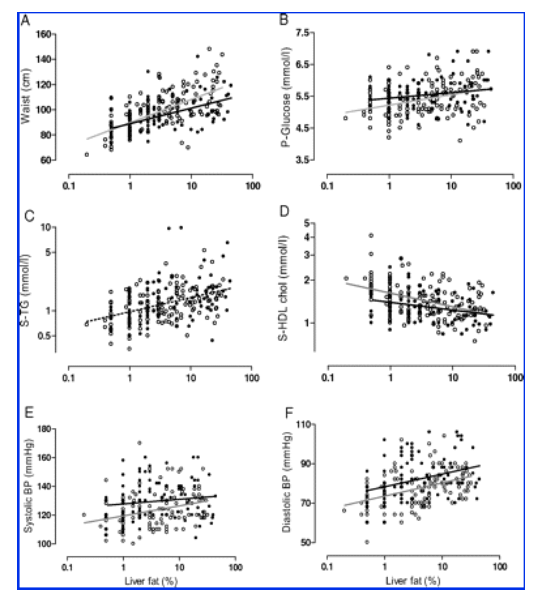
FIG. 2. The relationships between liver fat and body composition features. Liver fat is associated with BMI [r = 0.54, P < 0.0001 for women (n = 161); r = 0.52, P < 0.0001 for men (n = 107)] (A), percent body fat [r = 0.39, P < 0.0001 for women (n = 148); r = 0.62, P < 0.0001 for men (n = 97)] (B), intraabdominal fat [r = 0.64, P < 0.0001 for both women (n = 128) and men (n = 93)] (C), and abdominal sc fat [r = 0.43, P < 0.0001 for women (n = 128); r = 0.45, P < 0.0001 for men (n = 93)] (D). Symbols as in Fig. 1.
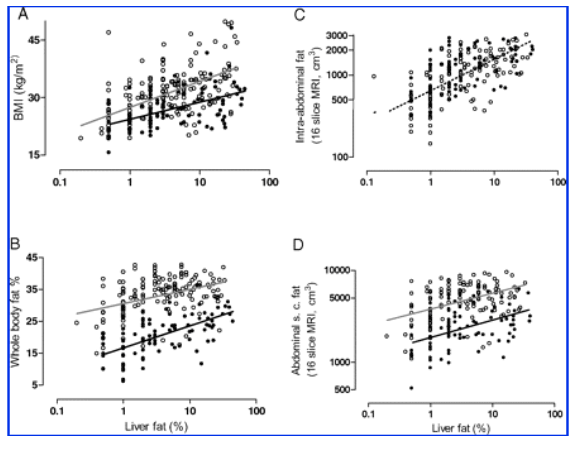
FIG. 3. The relationships between liver fat and fS-insulin, fS-C-peptide, and liver enzymes. Liver fat is associated with fS-insulin [r = 0.61, P < 0.0001 (r = 0.39, P < 0.0001) for both men (n = 89) and women (n = 162)] (A) and fS-C-peptide [r = 0.62, P < 0.0001 (r = 0.36, P < 0.0001) for both men (n = 76) and women (n = 109)] (B) and serum (S) ALT [r = 0.39, P < 0.0001 for women (n = 162); r = 0.44, P < 0.0001 for men (n = 109)] (C) and S-AST [r = 0.27, P = 0.0005 for women (n = 162); r = 0.31, P = 0.0012 for men (n = 109)] (D) concentrations. Correlation coefficients and their significances adjusted for age and BMI are given in parentheses. Symbols as in Fig. 1.
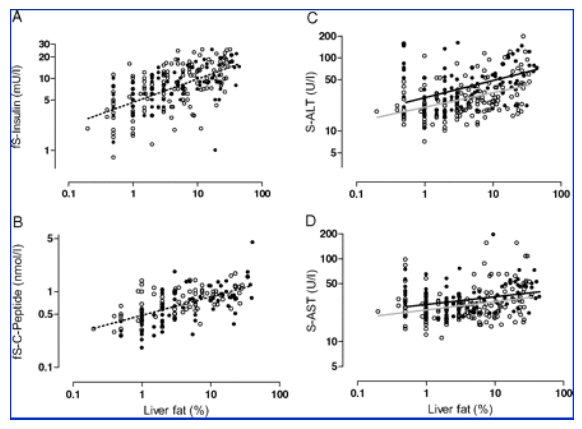
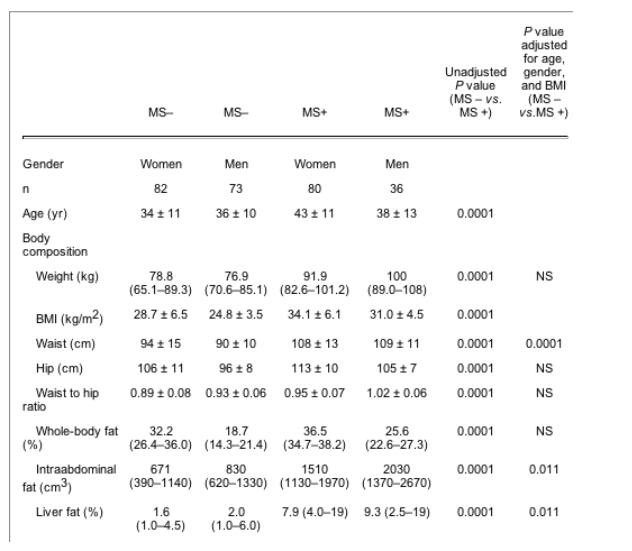
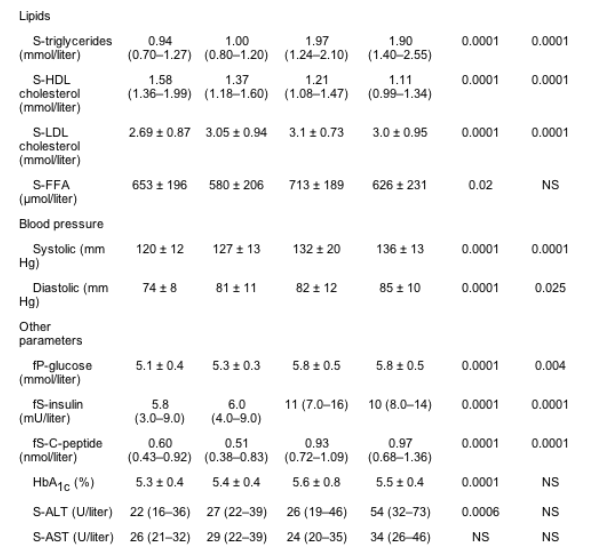
The regression lines representing the relationships between liver fat and components of the metabolic syndrome are depicted in Fig. 1. The regression lines relating liver fat to components of the metabolic syndrome were not significantly different between subjects with and without the metabolic syndrome (data not shown). A total of 108 subjects (68 women, 40 men) had increased liver fat content (>5.56%) (29), and 73 (68%) of them met criteria for the metabolic syndrome (52 women, 21 men). Inclusion or exclusion of the subjects using antihypertensives or lipid lowering drugs (a total of 33 subjects) did not alter the results (data not shown).
Body composition. Figure 2 depicts the relationships between liver fat and BMI, whole body fat percent, and intraabdominal fat measured by MRI. Women had less liver fat for the same BMI and whole body fat percent than men, whereas the relationship between liver fat and intraabdominal fat were similar in both women and men. Liver fat content was better correlated with intraabdominal than abdominal sc fat in both women and men. Both intraabdominal and sc fat volumes were significantly higher in subjects with than without the metabolic syndrome independent of age, gender, and BMI.
Other features. As shown in Table 2, after adjustment for age, gender, and BMI, subjects with the metabolic syndrome differed from those without the syndrome with respect to all components of the syndrome. Subjects with the metabolic syndrome also had significantly higher fasting serum insulin and C-peptide concentrations than those without the syndrome independent of age, gender, and BMI. Indeed, of all parameters analyzed, fasting serum insulin and C-peptide concentrations were the strongest correlates of liver fat content (r = 0.61; P < 0.0001 and r = 0.62; P < 0.0001, respectively). After adjustment for age, gender and BMI, these associations remained extremely significant [fasting serum (fS)-insulin: r = 0.39, P < 0.0001; C-peptide: r = 0.36; P < 0.0001]. The relationships could be characterized by a single regression line because neither the slopes nor the intercepts differed between men and women (Fig. 3).
The relationship between liver fat content and liver enzymes
Serum ALT and AST concentrations were positively correlated with liver fat in both women and men (Fig. 3). There was no difference between the slopes of the regression lines relating liver fat to ALT and AST in the two groups, but the y-intercepts were significantly lower in women than men. This difference averaged 7.3 ± 1.1 U/liter for serum ALT and 3.9 ± 1.0 U/liter for serum AST. After adjusting for age and BMI, liver fat retained its associations with both serum ALT (r = 0.32, P < 0.0001 for women; r = 0.38, P < 0.0001 for men) and AST (r = 0.31, P < 0.0001 for women; r = 0.28, P = 0.003 for men) concentrations.
Serum ALT concentrations were elevated in 30 women (19%) and 21 men (19%), in whom liver fat averaged 14 ± 12 and 18 ± 15%, respectively (NS). Among the individuals with elevated serum ALT, 23 (46%) met the criteria for the metabolic syndrome (13 women, 10 men). Serum AST concentrations appeared to be elevated in 34 women (21%) and 23 men (21%), in whom liver fat averaged 14 ± 11 and 16 ± 13%, respectively (NS). Among the individuals with elevated serum AST, 26 subjects (39%) were diagnosed with the syndrome (18 women, nine men).
Subjects and Methods
Subjects
A total of 271 nondiabetic subjects were recruited primarily by newspaper advertisements and contacting occupational health services using the following inclusion criteria: age 20-65 yr and no known acute or chronic disease based on history and physical examination and standard laboratory tests (blood counts, serum creatinine, TSH, electrolyte concentrations, and electrocardiogram). Exclusion criteria included pregnancy and clinical or biochemical evidence of any significant disease other than obesity. Elevated liver enzymes [serum (S) alanine aminotransferase (ALT), aspartate aminotransferase (AST) and -glutamyl transferase] were not exclusion criteria. However, subjects with serologic evidence of hepatitis B or C, autoimmune hepatitis, clinical signs or symptoms of inborn errors of metabolism, or a history of use of toxins or drugs associated with liver steatosis were excluded, as were subjects consuming more than 20 g of alcohol per day. A total of 20 subjects were receiving medications for hypertension (Ca-channel blockers or angiotensin-converting enzyme inhibitors), six subjects were receiving medications for dyslipidemia (statins), and seven subjects were receiving medications for both hypertension and dyslipidemia. Nineteen percent of the women were postmenopausal. If eligible, the subjects were studied after an overnight fast to assess body composition and features of insulin resistance, as detailed below. All except 75 subjects have previously participated in metabolic studies (3, 10, 13, 19). All protocols were approved by the Ethics Committee of the Helsinki University Central Hospital, and each subject provided written informed consent.
Diagnosis of the metabolic syndrome
The metabolic syndrome was defined according to criteria of the International Diabetes Federation: central obesity (waist circumference 94 cm in men and 80 cm in women) and at least two of the following factors: 1) serum triglycerides 1.70 mmol/liter or greater or specific treatment for this lipid abnormality; 2) serum HDL cholesterol less than 1.03 mmol/liter in men and less than 1.29 mmol/liter in women or specific treatment for this lipid abnormality; 3) systolic blood pressure 130 mm Hg or greater or diastolic blood pressure 85 mm Hg or greater or treatment for previously diagnosed hypertension; 4) fasting plasma glucose 5.6 mmol/liter or greater or previously diagnosed type 2 diabetes.
Liver fat content (proton spectroscopy)
Localized single voxel (2 x 2 x 2 cm3) proton spectra were acquired using a 1.5-T whole-body system (Magnetom Vision; Siemens, Erlangen, Germany), which consisted of a combination of whole-body and loop surface coils for radiofrequency transmitting and signal receiving. T1-weighted high-resolution magnetic resonance imaging (MRI) scans were used for localization of the voxel of interest within the right lobe of the liver. Magnetic resonance spectroscopy measurements of the liver fat were performed in the middle of the right lobe of the liver at a location that was individually determined for each subject; vascular structures and sc fat tissue were avoided when selecting the voxel. Subjects lay on their stomachs on the surface coil, which was embedded in a mattress to minimize abdominal movement due to breathing. The single voxel spectra were recorded using the stimulated-echo acquisition mode sequence, with an echo time of 20 msec, a repetition time of 3000 msec, a mixing time of 30 msec, 1024 data points over 1000 kHz spectral width with 32 averages. Water-suppressed spectra with 128 averages were also recorded to detect weak lipid signals. A short echo time and long repetition time was chosen to ensure a fully relaxed water signal, which was used as an internal standard. Chemical shifts were measured relative to water at 4.80 ppm. The methylene signal, which represents intracellular triglyceride, was measured at 1.4 ppm. Signal intensities were quantified by using an analysis program, VAPRO-MRUI (http://www.mrui.uab.es/mrui/). Spectroscopic intracellular triglyceride content (liver fat) was expressed as a ratio of the area under the methylene peak to that ender the methylene and water peaks (x 100 = liver fat percent). This measurement has been validated against histologically determined lipid content (20) and against estimates of fatty degeneration or infiltration by x-ray computer-assisted tomography by us (4) and others (21). All spectra were analyzed by physicists who were unaware of any of the clinical data. The reproducibility of repeated measurements of liver fat in nondiabetic subjects studied on two occasions in our laboratory is 11% (22).
Intraabdominal fat and sc fat (MRI)
In 128 of the 162 women and 93 of the 109 men, a series 16 of T1-weighted transaxial scans were acquired from a region extending from 8 cm above to 8 cm below the fourth and fifth lumbar interspace (16 slices, field of view 375 x 500 mm2, slice thickness 10 mm, breath-hold repetition time 138.9 msec, echo time 4.1 msec). Intraabdominal and sc fat areas were measured using an image analysis program (Alice 3.0; Parexel, Waltham, MA). A histogram of pixel intensity in the intraabdominal region was displayed, and the intensity corresponding to the nadir between the lean and fat peaks was used as a cutoff point. Intraabdominal adipose tissue was defined as the area of pixels in the intraabdominal region above this cutoff point. For calculation of sc adipose tissue area, a region of interest was first manually drawn at the demarcation of sc adipose tissue and intraabdominal adipose tissue, as previously described (4).
Other measurements
In 148 women and 97 men, the percent body fat was determined using bioelectrical impedance analysis (bioelectrical impedance analyzer system, model number BIA-101A; RJL Systems, Detroit, MI) (21). Waist circumference was measured midway between spina iliaca superior and the lower rib margin and hip circumference at the level of the greater trochanters (23). Body weight was recorded to the nearest 0.1 kg using a calibrated weighting scale (Soehnle, Monilaite-Dayton, Finland) with subjects barefoot and wearing light indoor clothing. Body height was recorded to the nearest 0.5 cm using a ruler attached to the scale. Blood pressure was measured in the sitting position after 10-15 min of rest using a random-zero sphygmomanometer (Erka, Chemnitz, Germany). Blood samples were taken after an overnight fast for measurement of fasting plasma glucose, fasting serum insulin, and C-peptide, hemoglobin A1c (HbA1c), liver enzymes, serum triglycerides, and total and HDL cholesterol concentrations.
Analytical procedures
Plasma glucose concentrations were measured in duplicate using the glucose oxidase method using Glucose Analyzer II (Beckman Instruments, Fullerton, CA) (24). Serum-free insulin concentrations were measured with the Auto-DELFIA kit (Wallac, Turku, Finland), and C-peptide concentrations by RIA (25). HbA1c was measured by HPLC using the fully automated glycosylated hemoglobin analyzer system (Bio-Rad, Richmond, CA) (26). Serum total cholesterol, HDL cholesterol, and triglyceride concentrations were measured with the enzymatic kits from Roche Diagnostics using an autoanalyzer (Roche Diagnostics Hitachi, Hitachi Ltd., Tokyo, Japan). The concentrations of low-density lipoprotein cholesterol were calculated using the Friedewald formula (27). Serum ALT and serum AST activities were determined as recommended by the European Committee for Clinical Laboratory Standards. Serum free fatty acid (FFA) concentrations were measured using a fluorometric method (28).
Statistical analyses
Nonnormally distributed data were used after logarithmic (base 10) transformation. If distributed normally, data are shown as means ± SD, whereas nonnormally distributed data are shown as median (25% percentile, 75% percentile). The unpaired Student's t test was used to compare mean values between men and women. Analysis of covariance was used to compare slopes and intercepts of regression lines for men and women. If neither the slopes nor intercepts differed between women and men, a common regression equation was calculated for all data. Analysis of covariance was used to adjust for age, gender, and BMI.
Calculations were made using GraphPad Prism (version 4.00 for Windows; GraphPad Software, San Diego, CA), SysStat Statistical Package (version 10; SysStat, Evanston, IL), and SPSS (version 11.0 for Windows; SPSS, Chicago, IL). P < 0.05 was considered statistically significant.
|
|
| |
| |
|
|
|